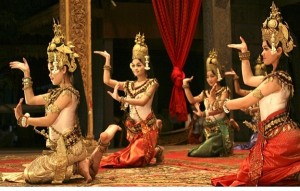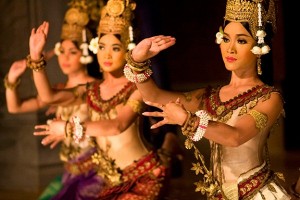Apsara dance is a form of Cambodian classical dance, popularly known as Cambodian Royal Ballet. It makes an integral part of Khmer culture and Khmer civilisation, as depicted on the walls of Angkor’s temples. Travel to Cambodia
Khmer classical dance derived from Indian court dance, which traces its origins to the apsarases of Hindu mythology, heavenly female nymphs who were born to dance for the gods. The traditions of Thailand and Java (in Indonesia) are also influenced by the music and dance of Cambodia. Traditional Khmer dance is better described as “dance – drama” because it is not merely dance but also means to convey a story or message. Read more tours in Cambodia
In Apsara dancing, women wear glittering silk tunics, sequinned tops and elaborate golden headdresses, they execute their movements with great deftness and deliberation, knees bent in plié, heels touching the floor first at each step, coy smiles on their faces. Every position has its own particular symbolism. For example, a finger pointing to the sky shows “today”, whereas standing sideways to the audience with the sole of the foot facing upwards represents “flying”. In fact, the Apsara dance seems to be composed of numerous gestures rather than steps. And the Apsara gesture is called “celestial gesture” in the Apsara dance. It is significant of the beauty of the Khmer lady and the symbol of the Khmer Nation since Angkor period. The hand gestures in Khmer classical dance are called “kbach”. They form a sort of alphabet and indicate various things from nature such as fruit, flowers and leaves. They are used in different combinations and transitions in accordance with movements of legs and feet, to convey different thoughts and concepts. The way in which they are presented, the position of the arm and the position of the hand relative to the arm can also affect their meaning.
These days, the Royal University of Fine Arts in Phnom Penh takes much of the responsibility for training dancers, who are chosen not only for aptitude but for the flexibility and elegance of their hands. It usually takes six years for students to learn the 1500 intricate positions, and a further three to six years for them to attain the required level of artistic maturity. The Royal University of Fine Arts mounts performance of Apsara dance on special occasions in front of Angkor Wat and sometimes in Phnom Penh – Phnom Penh highlights 4D3N. However, visitors are able to watch both types of Cambodian dance in the cultural performances held by hotels and restaurants in Phnom Penh and Siem Reap.
The Indochina Voyages team.
Read more:









